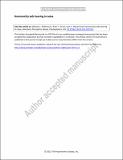Harmonicity aids hearing in noise
Author(s)
McPherson, Malinda J.; Grace, River C.; McDermott, Josh H.
Download13414_2021_2376_ReferencePDF.pdf (5.365Mb)
Open Access Policy
Open Access Policy
Creative Commons Attribution-Noncommercial-Share Alike
Terms of use
Metadata
Show full item recordAbstract
Abstract
Hearing in noise is a core problem in audition, and a challenge for hearing-impaired listeners, yet the underlying mechanisms are poorly understood. We explored whether harmonic frequency relations, a signature property of many communication sounds, aid hearing in noise for normal hearing listeners. We measured detection thresholds in noise for tones and speech synthesized to have harmonic or inharmonic spectra. Harmonic signals were consistently easier to detect than otherwise identical inharmonic signals. Harmonicity also improved discrimination of sounds in noise. The largest benefits were observed for two-note up-down “pitch” discrimination and melodic contour discrimination, both of which could be performed equally well with harmonic and inharmonic tones in quiet, but which showed large harmonic advantages in noise. The results show that harmonicity facilitates hearing in noise, plausibly by providing a noise-robust pitch cue that aids detection and discrimination.
Date issued
2022-01-31Department
Massachusetts Institute of Technology. Department of Brain and Cognitive Sciences; McGovern Institute for Brain Research at MIT; Center for Brains, Minds, and MachinesPublisher
Springer US
Citation
McPherson, Malinda J., Grace, River C. and McDermott, Josh H. 2022. "Harmonicity aids hearing in noise."
Version: Author's final manuscript